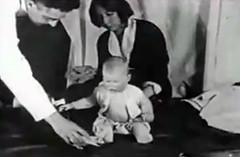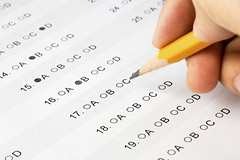| 4794586719 | child development | An area of study devoted to understanding constancy and change from conception to adolescence. Part of dev science (4) |  | 0 |
| 4794595740 | developmental science | Includes all changes we experiencd |  | 1 |
| 4794613133 | applied importance or | practical importance (4) | 2 | |
| 4794617732 | interdisciplinary | large storehouse of information about child development (4) | 3 | |
| 4794624519 | List and describe the Domains of Development. | PEC* Physical- bodily functions; health; proportions; motor & perceptual capacities Cognition- intellectual abilities; verbal; self-esteem Emotional & Social- Biggest challenge; communication; understanding; moral reasoning; relationships; behavior (5) |  | 4 |
| 4794636192 | Each Domain of Dev can have effect on the other. T or F?` | T. ex. crawling (physical) effects cognition (5) |  | 5 |
| 4794655196 | List the 5 Periods of Dev and ages. | PI Ema* Prenatal: conception to birth Infancy and Toddlerhood: 0-2 Early Childhood: 2-6 Middle Childhood: 6-11 Adolescence: 11-18 (6) |  | 6 |
| 4794669409 | Prenatal | conception-birth. Most rapid change. In the womb (6) |  | 7 |
| 4794672834 | Infancy and Toddlerhood | 0-2 yrs. Body and brain change. beginnings of language and first intimate ties to others. First steps (6) |  | 8 |
| 4794680913 | Early Childhood | 2-6 yrs. Refined motor skills. Longer body. More self-controlled/sufficient. Make believe play starts. Language and thought expand fast. Morality evident. Friends. (6) |  | 9 |
| 4794687032 | Middle Childhood | 6-11 yrs. Master new responsibilities like adult ones. Improved athletic ability. Involvement in games with more rules. Logical thought process-reading, math, writing etc. Understand friends and self. (6) |  | 10 |
| 4794696456 | Adolescence | 11-18 yrs. transition to adulthood. Puberty. Complex, abstract, and idealistic thought process. Independent morals. (6) |  | 11 |
| 4794703701 | Emerging Adulthood | 18-mid/late 20's. Intensify exploration of love, career, values. higher ed (6) |  | 12 |
| 4794709966 | theory | An orderly, integrated set of statements that describe (physical), explains (what's the gain?), and predicts behavior. Guide and Give meaning to what we see. Serve as sound basis for practical action Depends on scientific verification. Must be tested (7) |  | 13 |
| 4794724235 | scientific varification | Research procedures agreed on by the scientific community. (7) |  | 14 |
| 4794734699 | 3 Basic Issues? | Continuous or Discontinuous? One course of dev, or many? Nature vs Nurture? (7) |  | 15 |
| 4794743591 | What is the difference between the immature and mature being? | Amount or complexity (7) |  | 16 |
| 4794750924 | continuous | A process of gradually adding more of the same types of skills that were there to begin with. (8) |  | 17 |
| 4794756784 | discontinuous | A process by which new ways of understanding and responding to the world emerge at specific times. Like Stairs. |  | 18 |
| 4794769272 | Stages | Qualitative changes in thinking, feeling, and behaving that characterize specific periods of dev. Stairs- discontinuous |  | 19 |
| 4796125780 | context | Layered and complex unique combinations of personal and environmental circumstances that can result in diff path of change. |  | 20 |
| 4796128413 | Nature-nurture controversy | Are genetic or environmental factors are more important in influencing development? |  | 21 |
| 4796130601 | stability means? | Children who are high or low in a characteristic will remain so at later ages | 22 | |
| 4796133008 | What establishes a lifelong pattern of behavior? | early experiences and environment |  | 23 |
| 4796135552 | plasticity | development through life is open to change in response to influential experiences. |  | 24 |
| 4796137109 | stability vs plasticity | change or no change | 25 | |
| 4796142117 | Medieval Times views | Childhood (7-8yrs) regarded as separate period/phase of life with special needs, lawful protections. Loose clothing. Look up to adults. Religious but kids possessed by devil |  | 26 |
| 4798156840 | 16th cent views | Puritan belief (kids born evil and had to be civilized). "child depravity." Over time adopted moderate balance between severity and permissiveness |  | 27 |
| 4798161873 | 17th cent views | John Locke "tabula rasa" (blank slate- need to be taught). Locke believed in kindness and compassion w positive words to help kids. |  | 28 |
| 4798169896 | John Locke | Tabula Rasa (blank slate). 17th cent. continuous dev. Nurture. many courses of dev. High plasticity at later ages. Kids do little to shape their own destiny |  | 29 |
| 4798175106 | 18th cent views | Jean-Jacques Rousseau says kids are noble savages. Natural maturation. |  | 30 |
| 4798177869 | noble savages | kids endowed w sense of right and wrong. built-in moral sense |  | 31 |
| 4798184302 | Jean-Jacques Rousseau | Kids are noble savages (inborn moral compass). 4 stages: infancy, childhood, late childhood, late childhood, adolescence. Stage and maturation. Discontinuous stagewise process that follows a single, unified course mapped by nature. |  | 32 |
| 4798201634 | Darwin | Theory of Evolution: natural selection and survival of the fittest. Human evolution and child growth |  | 33 |
| 4798211027 | G. Stanley Hall | Most influential in Normative Period/20th cent. Founder of Child-study Movement. Dev is a maturational process. |  | 34 |
| 4798214507 | maturational process | Hall and Gesell. genetically determined series of events that unfold automatically like a flower |  | 35 |
| 4798217611 | Normative approach | Hall and Gesell. What children are like. Measures of behavior are taken on large numbers of individuals and age-related averages are computed to represent typical development. |  | 36 |
| 4798223980 | Gesell | First to make knowledge about child dev meaningful to parents by telling them what to expect at each age. Work w Hall on maturational process, normative approach. books |  | 37 |
| 4798229110 | who made the first IQ test? | Binet and Simon. Stanford-Binet Intelligence scale |  | 38 |
| 4798238084 | Mid 20th cent theories are: | Freud, Erikson, Watson, Bandura, Piaget |  | 39 |
| 4798243187 | psychoanalytic perspective | Freud. Discontinuous Kids move through series of stages which they confront conflicts between biological drives and social expectations. |  | 40 |
| 4800194558 | psychosexual theory | Freud. Discontinuous Emphasizes that how parents manage their child's sexual and aggressive drives in the first few years is crucial for healthy personality development. |  | 41 |
| 4800276667 | id | Freud. Basic bio drives. Selfish |  | 42 |
| 4800277110 | ego | Freud. Emerge in infancy. Conscious rational part of personality. Selfish |  | 43 |
| 4800280532 | superego | Freud. Conscience. complex tasks. rational |  | 44 |
| 4800287856 | Freud's Psychosexual stages | phallic: superego formed. Latency: social values from adults acquired. superego strenthens |  | 45 |
| 4800186554 | Erikson's Psychosocial Stages | Healthy or maladaptive outcomes? |  | 46 |
| 4800304204 | psychosocial theory | Erikson. In addition to meditation between id impulses and superego demands, ego makes a positive contribution to dev, acquiring attitudes and skills that make the individual an active, contributing member of society. |  | 47 |
| 4800329481 | clinical or case study | descriptive research approach to obtain an in-depth analysis of a person, group, or phenomenon. Techniques include interviews, observation, tests, records |  | 48 |
| 4800337662 | Behaviorism | Watson, Bandura, Pavlov, Skinner. Continuous. directly observable events-stimuli and responses- are the appropriate focus of the study. Criticized for underestimating kid's contributions to their own dev. |  | 49 |
| 4800340941 | Classical conditioning | Pavlov. |  | 50 |
| 4800346593 | Watson | Wanted to see if CC could be applied to children behavior. Teaches 1 yr old to fear a rabbit w loud noises |  | 51 |
| 4800351679 | Skinner | Operant conditioning theory. Skinner box. |  | 52 |
| 4800353683 | operant conditioning | Punishment, pos & neg reinforcement |  | 53 |
| 4800357004 | Social learning theory | Albert Bandura. emphasizes modeling/imitation or observational learning as powerful source of dev. BoBo doll exp |  | 54 |
| 4800362783 | Bandura | stress importance of cognition/thinking. Social Cognitive approach. Self-efficacy (feeling they can succeed). |  | 55 |
| 4800370481 | Applied Behavior analysis | Consists of observations of relationships between behavior and environmental events, followed by systematic changes in those events based on procedures of conditioning and modeling. Goal to eliminate undesirable behavior and increase desired. |  | 56 |
| 4800389719 | cognitive-dev theory | children actively construct knowledge as they manipulate and explore their world. Adapt physically and mentally to world. |  | 57 |
| 4800382006 | Piaget's Stages of Cog Dev | Discontinuous Stages and Clinical interviews (20) |  | 58 |
| 4800408215 | information processing | Continuous. Perspetive that human mind viewed as a symbol-manipulating system through which info flows. Continuous change: Input -> output |  | 59 |
| 4800422162 | developmental cognitive neuroscience | brings psych, bio, neuroscience, meds researchers together to study relationship between brain and child's cog processing and behavior patterns. |  | 60 |
| 4800436037 | developmental social neuroscience | Devoted to studying the relationship between changes in the brain and emotional and social dev. Autism brain has disrupted networks that lead to impaired soc skills, language delays, and repetitive motor ehavior. |  | 61 |
| 4800456286 | Ethology | Continuous and discontinuous. Concerned w adaptive, or survival value of behavior and its evolutionary history. Darwin. Lorenz and Tinbergen imprinting |  | 62 |
| 4800488225 | critical period | time span child is biologically prepared to acquire certain adaptive behaviors from environment |  | 63 |
| 4800498309 | sensitive period | a time or stage in a person's development when they are more responsive to certain stimuli and quicker to learn particular skills. Harder to induce later development |  | 64 |
| 4800511738 | evolutionary developmental psychology | Continuous and discontinuous. Seeks to understand the adaptive value of species-wide cog, emotional, an social competencies as they change w age. Aim to understand entire person-environment system. |  | 65 |
| 4800521342 | Sociocultural theory | Vygotsky. How culture is transmitted to the next generation. Social Interaction is necessary for children to acquire the ways of thinking and behaving that make up a communities culture |  | 66 |
| 4800532015 | Vygotsk's theory is? | Continuous and discontinuous Sociocultural theory. Kids cog dev are a socially mediated process in which children depend on assistance from adults and more-expert peers as they tackle new challenges |  | 67 |
| 4800537779 | cross-cultural research | cultures surround kid's in an environment meant to set the child up for success in that culture. |  | 68 |
| 4800549671 | Ecological systems theory | Bronfenbrenner. Views child as developing within a complex system of relationships affected by multiple levels of the surrounding environment. |  | 69 |
| 4800553436 | Bronfenbrenner | Ecological systems theory. Sees environment as series of interrelated nesteds structures that form a functioning whole or system |  | 70 |
| 4800557422 | microsystem | Bronfenbrenner. Innermost level of environment. Consists of activities and interaction patterns in child's immediate surroundings. Bidirectional relationship. |  | 71 |
| 4800586361 | mesosystem | 2d level of Bronfenbrenne's model encompasses connections between microsystems like home, school, neighborhood, and child-care centers. |  | 72 |
| 4800591379 | exosystem | 3d level of Bronfenbrenner model. Consists of social settings that do not contain children but that affect their experiences in immediate settings. Formal and informal organizations: parents work, church, social networks (parents friends or extended family) |  | 73 |
| 4800604778 | macrosystem | outermost (4th) level of Bronfenbrenner model consists of cultural values, laws, customs, and resources. Laws, Work, customs, Values |  | 74 |
| 4801246635 | chronosystem | temporal dimension of Bronfenbrenner's model. Life changes imposed on the child. Birth or death of family, moving to new environments, divorce, marriage |  | 75 |
| 4801257753 | dynamic systems perspective | Continuous and Discontinuous. The child's mind, body, and physical and social worlds form an integrated system that guides mastery of new skills. This system is constantly in motion or___. Development is like web fibers branching out in many directions; continuous and stagewise transformations |  | 76 |
| 4801327426 | eclectic position | Blending several theories | 77 | |
| 4801329804 | hypothesis | prediction drawn directly from a theory |  | 78 |
| 4801332768 | research method | Specific activities of participants. Interview, test, observation |  | 79 |
| 4801333806 | research design | overall plans for research studies that permit best possible test of the investigator's hypothesis. More specific methods to answer your question. |  | 80 |
| 4801343738 | Research Method examples | Naturalistic observation, Structured observation clinical interview, structured interview/questionnaires/test Clinical/case study method (one child; prodigies) Ethnography (aim to understand culture through participant observation) |  | 81 |
| 4802452110 | longitudinal studies | participants are studied repeatedly and changes are noted as they get older |  | 82 |
| 4805681568 | Problems with Longitudinal studies are? | biased sampling selective attrition- people drop out of study practice effects- better test-taking skills or familiarity w test |  | 83 |
| 4802448614 | cohert effects | In longitudinal studies. Children born at the same time who are influenced by particular cultural and historical conditions | 84 | |
| 4802445296 | cross-sectional design | groups of people differing in age are studied at the same point in time | 85 | |
| 4805696975 | sequential designs | design in which they conduct several similar cross-sectional or longitudinal studies at varying times. | 86 | |
| 4805707442 | microgenetic design | An adaptation of the longitudinal approach, presents children with a novel task and follows their mastery over a series of closely spaced sessions. Within this, researchers observe how change occurs. Used in studying cognitive development. |  | 87 |
| 4805721942 | Children's Research rights/ethics are: | Protection from harm Informed consent/assent Privacy Knowledge of results- debrief for adults Beneficial treatments |  | 88 |
Ch 1 History, Theory, and Research Strategies Flashcards
Primary tabs
Need Help?
We hope your visit has been a productive one. If you're having any problems, or would like to give some feedback, we'd love to hear from you.
For general help, questions, and suggestions, try our dedicated support forums.
If you need to contact the Course-Notes.Org web experience team, please use our contact form.
Need Notes?
While we strive to provide the most comprehensive notes for as many high school textbooks as possible, there are certainly going to be some that we miss. Drop us a note and let us know which textbooks you need. Be sure to include which edition of the textbook you are using! If we see enough demand, we'll do whatever we can to get those notes up on the site for you!

